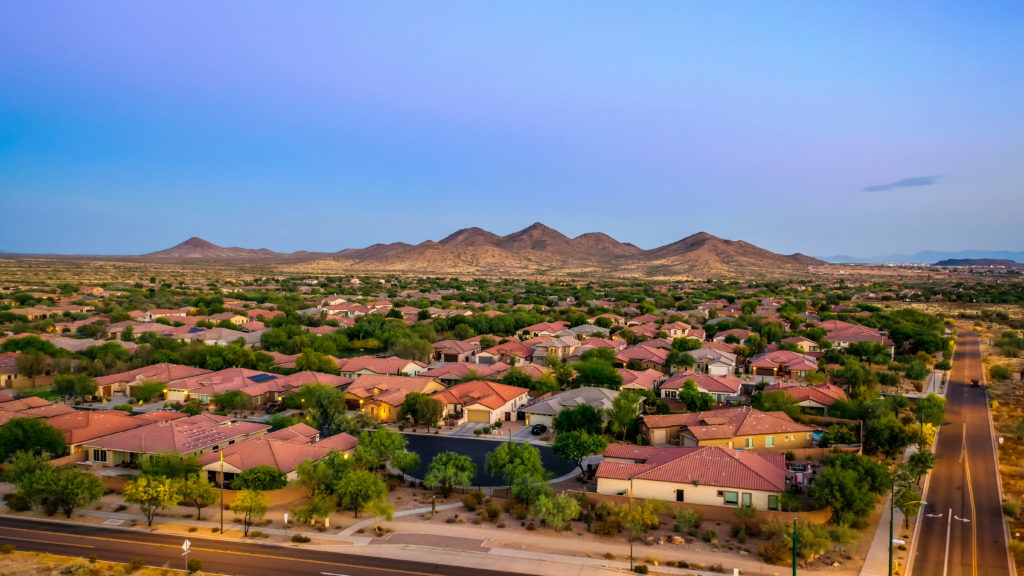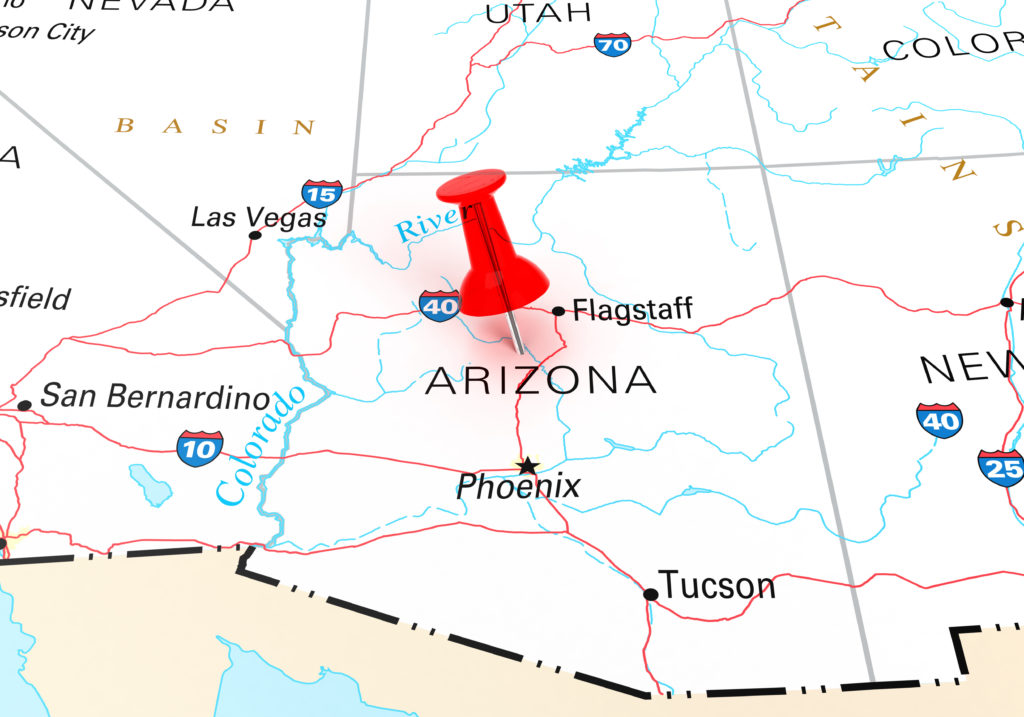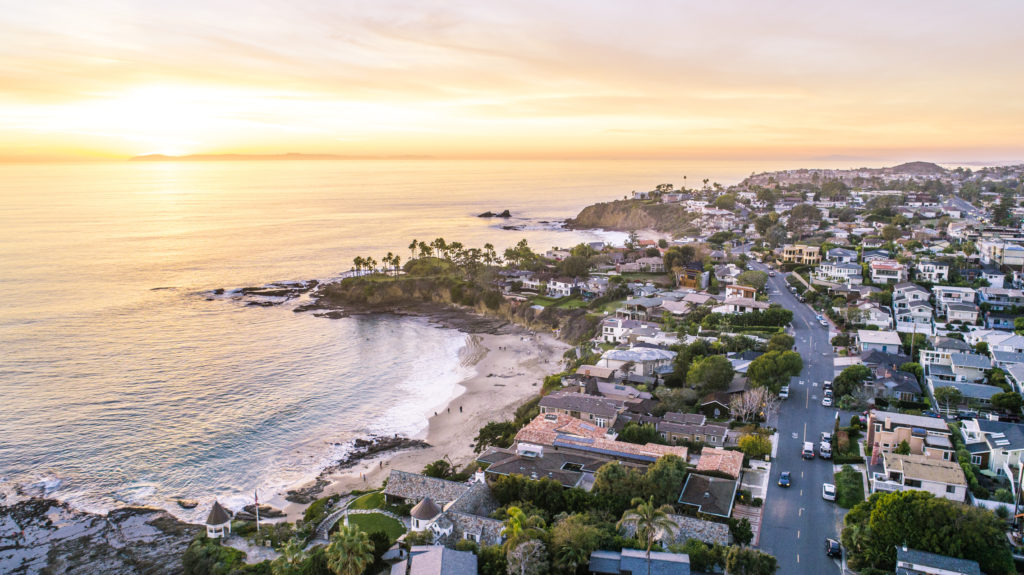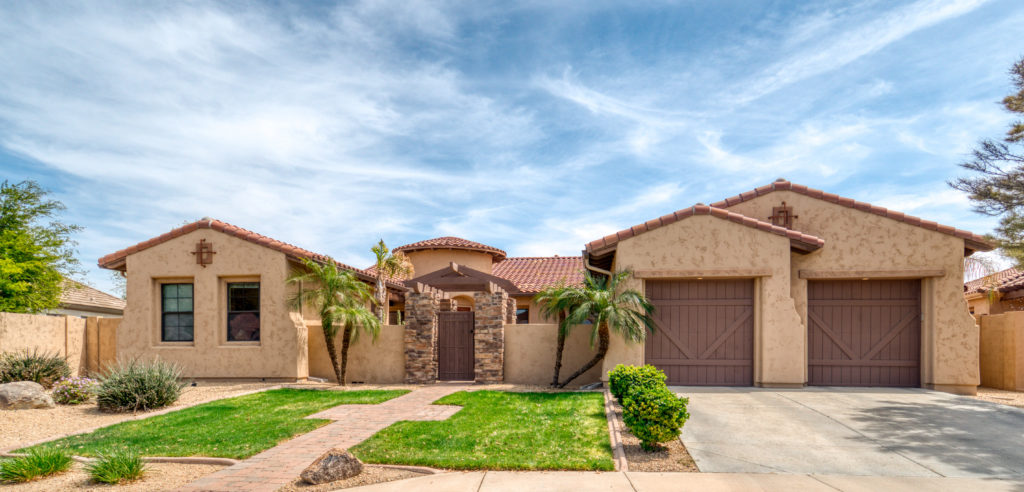Arizona, known as the Grand Canyon State, has been a relocation destination for many years as retirees flocked to the warmer climate. Today, the domestic migration to Arizona real estate still includes a high percentage of retirees. However, Arizona newcomers are choosing the state for a variety of reasons—from seeking better jobs and schools to fleeing states with higher taxes and skyrocketing housing prices.
Domestic Migration and Population in Arizona
Domestic migration is simply when people move from one state to another state or from one city to another city. The U.S. Census Bureau tracks these moves, generating statistics that allow us to see how a state, city, or region is growing or declining.
The state of Arizona has more than 7.2 million residents, a population increase of nearly two percent from 2020 to 2021. Ten years ago, the state’s population was only 6.3 million. According to Kiplinger, between 2010 and mid 2018, Arizona had a population growth of 12.2-percent. Why were people moving here? There are many answers to that question, but on average, home buyers relocate because of the diverse housing market.
One of its highest increases in population happened in 2021. Phoenix, the largest city, had a 2021 population increase of 1.7-percent. The steady rise in new residents may be attributed to domestic migration, from both out-of-state and in-state.
Where’s everyone coming from? From 2015 through 2019, more than 62,000 people moved from California to Arizona. Other states people left for Arizona include Washington, Texas, Colorado, and Illinois, according to AZ Big Media.
While moving motivations vary, many migrations are triggered by job availability, housing prices, and taxes. Illinois residents often list its high taxes as the reason for leaving the state. In 2019, more than 300,000 residents moved from Illinois to live in other states. Arizona continues to be one of the favorite choices.

Things to Know About Moving to Arizona
Arizona has a lot to offer residents, visitors, and anyone looking to buy a home in the Grand Canyon State. Arizona is an arid and semi-arid region that sees a yearly-average rainfall that is as little as three inches in its southwest region (Yuma). Beautiful blue skies, low humidity, and moderate temperatures make it an attractive option for home buyers. With its mix of desert, mountains, and metropolitan areas, Arizona has it all.
Moving to Arizona? A few facts and things to know:
- It’s the sixth largest state.
- It’s home to the Grand Canyon National Park. About six million people visit the Grand Canyon every year.
- Arizona has nearly 4,000 mountain peaks and summits.
- Tourism, micro-electronics, mining, aerospace, and agriculture are leading industries. (via VisitArizona.com)
- Phoenix is the capital and largest city in the state.
- The Phoenix metro area includes Mesa and Scottsdale and it spans all of Maricopa and Pinal Counties. The metro area is twelfth largest in the country.
- Other major metro areas within a one-day drive of Phoenix include Las Vegas, Albuquerque, Los Angeles, and San Diego. Its location has helped contribute to its increased inbound domestic migration and makes it an attractive vacation destination.
In 2020, the state of Arizona had an inbound domestic migration of 62-percent, as reported by the United Van Lines’ National Migration Study. The most common reasons for people moving to the state are:
- Tired of harsh winters
- Job availability
- Strong public school system
- Able to find bigger homes for less money
Looking at California versus Arizona Real Estate Market
Real estate prices can be a key motivating factor when making a move from one state to another. From 2006 to 2016, according to MarketWatch, more than one million people moved out of California than moved into the state. This was a time of extreme outbound domestic migration. For many making the move out of California, it was all about the state’s high cost of living and a housing market that was pricing out many potential buyers.
In the early 2000s, the house price index in California was in the upper $200’s, while Arizona’s was in the lower $200’s. But, California’s market continued to climb. It hit a high mark in 2006, with a house price index of nearly $650,000. It dipped in 2012 to the high $300’s, but then started to rise again.
Today, California has some of the highest average home values in the country. According to Zillow, typical home values in California in January 2020 were $559,000. Those numbers jumped to $727,000 in January 2021, an increase of more than 20-percent.
By comparison, Arizona’s typical home values in January 2020 were $268,000. Arizona real estate also saw an increase, but not as dramatic as California’s. For January 2021, Arizona’s typical home value is listed at $396,000.
With a shortage of available homes to buy, increasing mortgage rates, and a more than $300,000 difference in average home values, it’s no wonder Californians looked to Arizona as a place to relocate.
Arizona Real Estate Market: Then
When the housing crisis hit in 2007 and 2008, home values across the country fell dramatically, affecting cities of all sizes. Some of the hardest hit cities, between the housing crisis and the recession, were Detroit, Portland, Austin, Myrtle Beach, San Jose, and multiple communities in states like Ohio and Florida.
In Arizona, the cities of Phoenix and Tucson also suffered. The recession contributed to a significant decrease in real estate transactions as the housing market fluctuated. More homes were for sale, but people weren’t buying.
Reports from December 2008 reveal that new home sales were down by 60-percent in Phoenix, and home resale numbers were down by 72-percent. But you can’t keep the Valley of the Sun down. By 2012, those home sales were rebounding, and in the Phoenix metro area, home values were on the rise as well.

Real Estate in Arizona Today
There are many benefits to buying a home in Arizona today. The state has had a strong housing market since about 2011. The state has been able to accommodate the domestic migration of residents from other states like California, Illinois, Oregon, Minnesota, and more. Reports show that people moving into the Phoenix metro area from a long distance (usually from out-of-state) were able to find home values about $48,000 lower than their city of origination.
What, if anything, could affect the real estate market in Arizona? One answer: a pandemic. The World Health Organization (WHO) declared COVID-19 a pandemic on March 11, 2020.
In cities across the United States, the real estate market saw the same thing: an extreme shortage of homes for sale and more people wanting to buy homes. The shortage and demand caused an extreme increase in the number of home sales over the asking price. A home valued at about $200,000 may list for $210,000, but then, because of the supply-and-demand, it may end up selling for $250,000 or even $300,000. Many of these listings would sell the same day that they hit the market.
As the country moved into year two of the pandemic in 2021, the supply and demand issues persisted. However, the real estate market could be evening out once again. During the latter half of 2021, there was a better balance between supply and demand.
Real Estate in Arizona Tomorrow
Looking in particular at the Phoenix area, the real estate market continues to be what is considered a seller’s market, but one without the extreme demand seen during the height of the pandemic. This means that while listing prices may not be decreasing, the availability of properties for sale remains steady with the homes staying on the market longer. This can be good news for both sellers and buyers.
The Phoenix market continues to grow and is considered one of the highest appreciating areas in Arizona. Real estate professionals have reported that the Phoenix market offers home prices that “are now only back to where they were at the top of the real estate bubble in 2006, 12 years ago.”
In Phoenix and throughout Arizona, buyers can find homes priced lower than other metropolitan areas, available jobs, and a lower cost of living compared to states like California, New York, and areas of Illinois, Michigan, and Oregon.
Investment Properties in Arizona
With affordable real estate and amazing locations, buyers may also be looking to Arizona for investment properties. Tourism is one of the state’s leading industries, and owning a rental property in one of the prime areas can mean profit.
The Phoenix metropolitan area, which includes Scottsdale, is a haven for vacation rentals. And why not? It’s a hotspot for attractions, entertainment, professional sports, outdoor recreation, fine dining, and shopping. There are nearly 200 golf courses in the metro area plus 240 hiking trails, seven professional sports teams to cheer on, and thousands of acres of city parks to explore and enjoy. And that only begins to scratch the surface of what the area has to offer.
If you’ve ever dreamed about owning a vacation rental but were unsure of where to invest, the real estate market in Arizona may be calling. Check out vacation rentals in Phoenix/Scottsdale, Tucson, and Sedona, a scenic desert town just south of Flagstaff. Casago has must-see rentals in each of these cities, amazing locations perfect for the first-time visitor or seasoned snowbird who loves to winter in the Arizona sunshine.
Guests can rent a Phoenix condo for a night, a week, or even monthly. A rental with three bedrooms and two bathrooms is a more spacious and luxurious option when traveling with a family or group. It’s more private than a hotel, but still offers a prime location close to attractions, entertainment, and dining.
Looking to relocate?
Consider renting a house for a week or longer. It’s a great way to get to know the area. Living in a vacation rental versus staying at a resort or chain hotel puts you right in the neighborhood. It’s more like being a resident than a visitor. You can take the opportunity to shop where the locals shop, grab a coffee at the corner cafe, and enjoy a walk along the neighborhood trails.
When considering investment properties in Arizona, you can rely on Casago for premier, full-service property management. You don’t have to go it alone. Casago is there for you and can help your property reach its true revenue potential.
Arizona Real Estate 2022 and Beyond
While we don’t have a crystal ball for divining the future, we do know that 2022 and beyond looks bright for Arizona and its real estate market. As with anything, time will tell. But, for now, it may be worth that time to look into Arizona real estate, whether it’s an investment property, vacation home, or primary residence. The Grand Canyon State is waiting for you.












